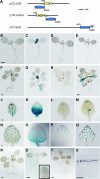Terminal flower2, an Arabidopsis homolog of heterochromatin protein1, counteracts the activation of flowering locus T by constans in the vascular tissues of leaves to regulate flowering time
- PMID: 14630968
- PMCID: PMC282816
- DOI: 10.1105/tpc.016345
Terminal flower2, an Arabidopsis homolog of heterochromatin protein1, counteracts the activation of flowering locus T by constans in the vascular tissues of leaves to regulate flowering time
Abstract
The flowering time of plants is tightly regulated by both promotive and repressive factors. Molecular genetic studies using Arabidopsis have identified several epigenetic repressors that regulate flowering time. Terminal flower2, (TFL2), which encodes a homolog of heterochromatin protein1 represses flowering locus T (FT) expression, which is induced by the activator constans (CO) in response to the long-day signal. Here, we show that TFL2, CO, and FT are expressed together in leaf vascular tissues and that TFL2 represses FT expression continuously throughout development. Mutations in TFL2 derepress FT expression within the vascular tissues of leaves, resulting in daylength-independent early flowering. TFL2 can reduce FT expression even when CO is overexpressed. However, FT expression reaches a level sufficient for floral induction even in the presence of TFL2, suggesting that TFL2 does not maintain FT in a silent state or inhibit it completely; rather, it counteracts the effect of CO on FT activation.
Figures





Similar articles
-
Arabidopsis TERMINAL FLOWER 2 gene encodes a heterochromatin protein 1 homolog and represses both FLOWERING LOCUS T to regulate flowering time and several floral homeotic genes.Plant Cell Physiol. 2003 Jun;44(6):555-64. doi: 10.1093/pcp/pcg091. Plant Cell Physiol. 2003. PMID: 12826620
-
Enabling photoperiodic control of flowering by timely chromatin silencing of the florigen gene.Nucleus. 2015;6(3):179-82. doi: 10.1080/19491034.2015.1038000. Epub 2015 May 7. Nucleus. 2015. PMID: 25950625 Free PMC article.
-
The balance between CONSTANS and TEMPRANILLO activities determines FT expression to trigger flowering.Curr Biol. 2008 Sep 9;18(17):1338-43. doi: 10.1016/j.cub.2008.07.075. Epub 2008 Aug 21. Curr Biol. 2008. PMID: 18718758
-
Just say no: floral repressors help Arabidopsis bide the time.Curr Opin Plant Biol. 2009 Oct;12(5):580-6. doi: 10.1016/j.pbi.2009.07.006. Epub 2009 Aug 18. Curr Opin Plant Biol. 2009. PMID: 19695946 Review.
-
Circadian Clock and Photoperiodic Flowering in Arabidopsis: CONSTANS Is a Hub for Signal Integration.Plant Physiol. 2017 Jan;173(1):5-15. doi: 10.1104/pp.16.01327. Epub 2016 Sep 29. Plant Physiol. 2017. PMID: 27688622 Free PMC article. Review.
Cited by
-
An explanatory model of temperature influence on flowering through whole-plant accumulation of FLOWERING LOCUS T in Arabidopsis thaliana.In Silico Plants. 2019;1(1):diz006. doi: 10.1093/insilicoplants/diz006. Epub 2019 May 15. In Silico Plants. 2019. PMID: 36203490 Free PMC article.
-
A florigen-expressing subpopulation of companion cells expresses other small proteins and reveals a nitrogen-sensitive FT repressor.bioRxiv [Preprint]. 2024 Aug 19:2024.08.17.608367. doi: 10.1101/2024.08.17.608367. bioRxiv. 2024. PMID: 39229231 Free PMC article. Preprint.
-
FTIP1 is an essential regulator required for florigen transport.PLoS Biol. 2012;10(4):e1001313. doi: 10.1371/journal.pbio.1001313. Epub 2012 Apr 17. PLoS Biol. 2012. PMID: 22529749 Free PMC article.
-
Photoperiodic Regulation of Florigen Function in Arabidopsis thaliana.Arabidopsis Book. 2015 Jun 24;13:e0178. doi: 10.1199/tab.0178. eCollection 2015. Arabidopsis Book. 2015. PMID: 26157354 Free PMC article.
-
Reproductive competence is regulated independently of vegetative phase change in Arabidopsis thaliana.Curr Biol. 2023 Feb 6;33(3):487-497.e2. doi: 10.1016/j.cub.2022.12.029. Epub 2023 Jan 11. Curr Biol. 2023. PMID: 36634678 Free PMC article.
References
-
- Ahmad, K., and Henikoff, S. (2002). Epigenetic consequences of nucleosome dynamics. Cell 111, 281–284. - PubMed
-
- Araki, T. (2001). Transition from vegetative to reproductive phase. Curr. Opin. Plant Biol. 4, 63–68. - PubMed
-
- Blazquez, M.A., Ahn, J.H., and Weigel, D. (2003). A thermosensory pathway controlling flowering time in Arabidopsis thaliana. Nat. Genet 33, 168–171. - PubMed
-
- Blazquez, M.A., and Weigel, D. (2000). Integration of floral inductive signals in Arabidopsis. Nature 404, 889–892. - PubMed
-
- Colasanti, J., and Sundaresan, V. (2000). ‘Florigen’ enters the molecular age: Long-distance signals that cause plants to flower. Trends Biochem. Sci. 25, 236–240. - PubMed
Publication types
MeSH terms
Substances
LinkOut - more resources
Full Text Sources
Other Literature Sources
Molecular Biology Databases

